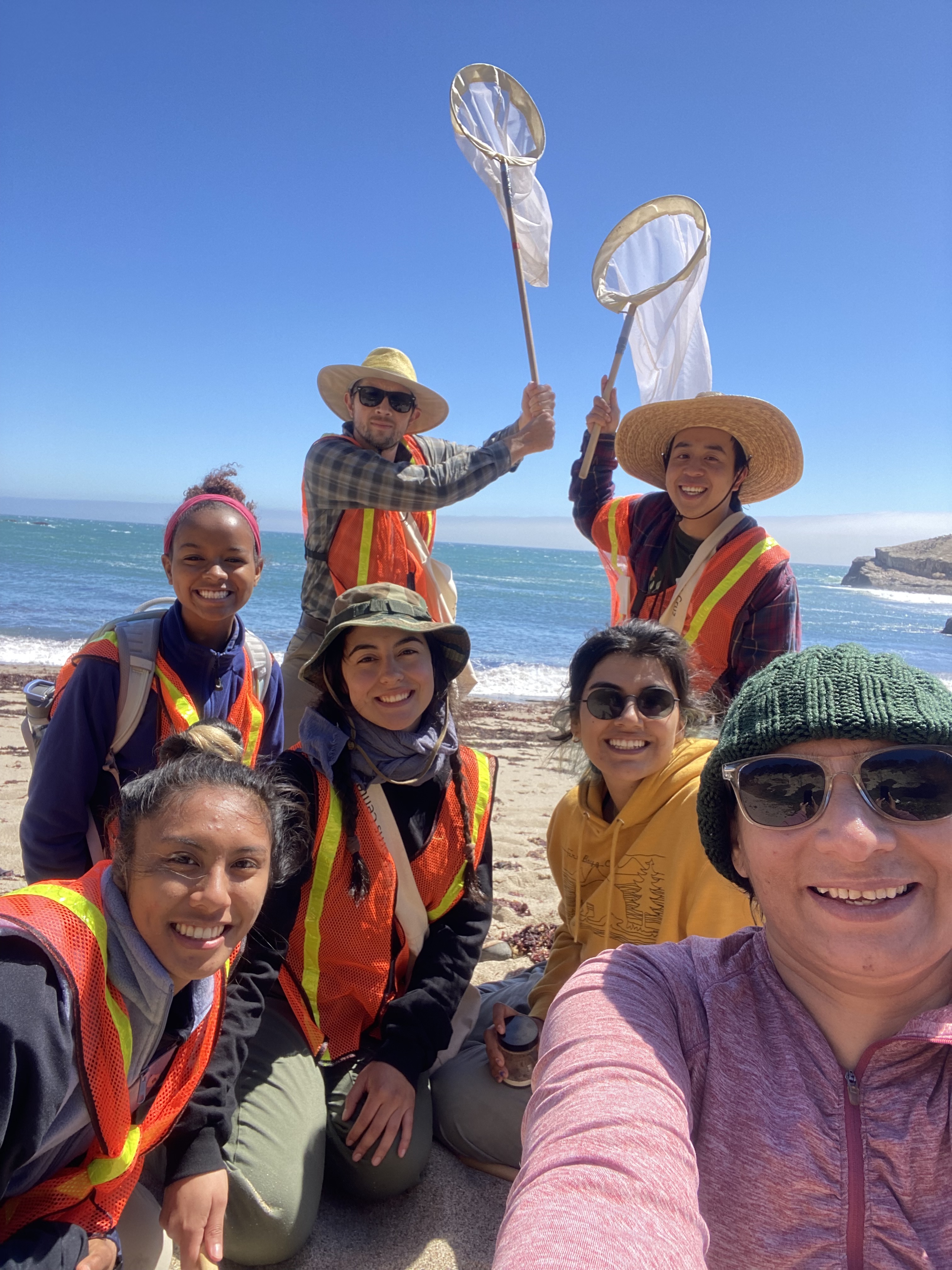Research Inspired by Randy Morgan
Recent Research
Several students from CAMINO and Doris Duke Scholars followed up on insect surveys conducted by Randy Morgan in the 1990s on the costal dune ecosystem.

Clockwise. Chiara Cantos (Camino), Natalie Reyes (Camino), Fana Scott (Doris Duke), Dr. Andy Kulikowski (Project Supervisor), Ph.D. candidate Justin Luong (Norris Center Gradute Fellow), Wendy Olvera (Camino), and Dr. Gizelle Hurtado (Norris Center Assistant Director).
To learn more about the research conducted by the CAMINO and Doris Duke Scholars see the links below.
Chiara Cantos examined how community compostion of native pollinators has changed since the 1990's and present day.
Fana Scott investagated how the richness of invasive plants affected native pollinator richness and whether there were differences in pollinator richness between the 1990's and present day.
Wendy Olvera looked at how the proportion of flies within the pollinator community changed between the 1990's and present day.
Natalie Reyes examined the number of native pollinator species on coast buckwheat and whether differences in plant richness between the 1990's and present day explained trends in buckwheat use.
Potential Future Research
Botanists Jim West and Dylan Neubauer recently published a list of potential research projects in the Scott Creek Watershed. Plants collected by Randy are listed as reference points against which future researchers should measure how plant populations and the watershed have changed. Read more here.
Past Research
Graduate Student Research Projects
- Dr. Adelia Barber (PhD UCSC Ecology and Evolutionary Biology) worked with Morgan himself to complete the field, greenhouse, and background research to describe a new species of clover, Trifolium piorkowskii.
- Dr. Tara Cornelisse (PhD UCSC Environmental Studies) used Morgan's insect collection data to study how best to manage and restore habitat for the federally endangered Ohlone Tiger Beetle.
- Dr. Juliet Oshiro (PhD UCSC Ecology and Evolutionary Biology) used Morgan's plant collections and field notes to study how plant phenology has changed over the past 25 years. She found that as annual minimum temperatures increased, and precipitation decreased, plants began flowering earlier and stopped flowering earlier, especially near the coast.
- Dr. Angelita Ashbacher (PhD UCSC Ecology and Evolutionary Biology) used Morgan's insect collections to study how pollinator networks have changed locally over the past 25 years.
- Andy Kulikowski (PhD candidate, Environmental Studies) in 2018-19 identified many new taxa within the fly families of Syrphidae and Bombyliidae.
Undergraduate Student Research Projects
- Cady Watts (Environmental Studies, 2015) created an exhibit about Morgan that is displayed in the main room of the Norris Center on campus.
- Michelle Pastor (Environmental Studies, 2018) wrote a biography about Morgan and created 4 illustrations that depict his contributions Santa Cruz natural history and conservation.
- Daniel Simoni (Environmental Studies, 2018) studied emergence patterns and plant associations with various bumblebee species (Bombus spp.). Daniel was able to closely track the behavior (emergence, reproduction and feeding) of male and females of multiple bumblebee species using Randy's detailed data.
- Jesse Laine (Ecology and Evolutionary Biology, 2018) examined bumblebee community dynamics over the 10 years that Randy sampled bumblebees in Santa Cruz County. He looked at temporal changes in bee richness as well as changes in the network of plants visited by these important pollinators.
- Alexandra Ahmad (Environmental Studies, 2019) summarized how lycaenid butterfly diversity had changed over the 10 years that Morgan collected insects in Santa Cruz.
- Jessica Correa (Environmental Studies, 2019) used the Morgan's collection to create a field guide to local species in the Syrphidae, an important fly pollinator family.
Personal Projects
- Revision of the genus Trifolium, with a number of new taxa described. See the Trifolium section for more information.
- Revision of Leptosiphon parviflorus. His manifesto on this species is now stored at Stanford University,.
